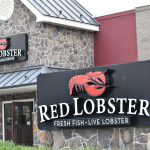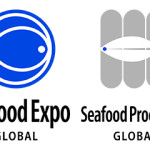The International Boston Seafood Show has begun, and exhibitors and attendees appear to be in good spirits, despite the foot of snow that fell in the city just days ago (you’d barely know it, though, because New Englanders know how to shovel).
Even though you can buy and sell seafood from virtually anywhere in the world thanks to today’s technology, it’s impossible to replicate the face-to-face interactions that make this industry dynamic. It’s why this event remains so important after more than 30 years. One day down, two to go. Here’s a sampling of what I’ve seen thus far:
On Saturday evening at the Westin Waterfront Hotel, I met with Paul Opitz, COO, and John Knorr, senior VP-sales for of Phillips Foods in Baltimore. They were really excited about Culinary Jumbo Lump and Super Lump Crab Meat, formulated crabmeat products for foodservice applications. The next day, the product won the Seafood Excellence Awards competition for best new foodservice product; it can be seen on display in the New Product Showcase. We also talked yellowfin tuna — a fish that’s been in short supply the past few Boston shows — and I almost got the two of them to spill a secret about a new product line in development. Almost.
I also met Steve Phillips for the first time on Sunday afternoon. He is recognized as a true pioneer and is one of the most respected men in the industry. When you read about fishery improvement projects and the positive changes that industry collaborations can make on behalf of the environment, Phillips’ work with blue-swimming crabs (namely, The National Fisheries Institute Crab Council) in Asia is one of the blueprints.
Earlier on Sunday, I shook hands with royalty. Chef Gregory Gourdet (pictured), who was crowned the King of American Seafood last summer, was at the Louisiana Seafood Promotion & Marketing Board, Booth 2233. It’s Gourdet’s first Boston Seafood Show, and his hairdo matched the occasion. If you can brave the mid-August heat and humidity of New Orleans, then the Great American Seafood Cook-Off should be on your bucket list.
From there I didn’t have to walk too far to run into Irvin Jackson, director of the Mississippi Seafood Marketing Program. There I sampled a smoking-hot Gulf shrimp and my first-ever irradiated oyster. Jackson says irradiated oysters taste the best of all the post-harvest processing techniques. Since it tasted like it was just pulled out of the water, he might be onto something.
Sticking in the South, I had to track down Harlon Pearce of Harlon’s LA Fish and the Louisiana Seafood Promotion & Marketing Board. Pearce was close friends with the late Mike Voisin of Motivatit Seafoods in Houma, La. I knew Mike pretty well and was devastated to hear of his passing last month. You can only wish there were more guys like Mike around. He will be sorely missed.
I’ve been wanting to know more about Verlasso’s “harmoniously raised” farmed salmon, so I made sure to find time to talk to Scott Nichols, one of Verlasso’s six directors. It’s a young company — it sold its first fish in September 2011 — but looks mature beyond its years; its branding and marketing efforts are sophisticated. Nichols described the company’s “feeder fish dependency ratio” as a more accurate way to measure what might be the aquaculture’s biggest issue for the future. A ratio of 1:1 is where Verlasso is now, thanks to omega-3-rich yeast in the fish feed, which has reduced the need for fishmeal and fish oil. The industry average, Nichols says, is 4:1. “The argument gets even better when you get below 1:1. And we have the knowledge to do that,” said Nichols, adding that within two or three years, the ratio could be in the neighborhood of 0.75:1. Now that would be something to celebrate.
I was very proud of my fellow Mainers today when Gov. Paul LePage announced that Maine’s iconic lobster fishery earned MSC certification. Can’t say I’m at all surprised that the fishery was deemed worthy of such recognition. Any opportunity to pursue new markets — the MSC eco-label may turn out to provide just that — is well worth it, and could help struggling fishermen, who just happen to be my neighbors. Congratulations especially to my man John Hathaway, president of Shucks Maine Lobster. Hathaway chairs the Fund for the Advancement of Sustainable Maine Lobster, the client for the certification. Way to go, Maine!
Eddie Diehl of Source to Plate stopped by the SeafoodSource/SeaFood Business media booth (No. 1300), and we chatted briefly about the new DNA rapid-response species identification test kit his company is developing for American red snapper, one of the most frequently (and illegally) substituted species around the country. “The industry needs another surveillance tool,” said Diehl. His test is highly accurate, he says, and can bring results in less than 40 minutes at room temperature. That’s innovation.
Michael Tlusty is one of the smartest guys in the room. I had a chance to sit down briefly with the director of research at the New England Aquarium, which is just down the road from the Boston Convention and Exhibition Center. Look for a NetWorking interview with Tlusty in an upcoming issue of SeaFood Business. We’re going to talk about aquaculture certification and his work in the “lobster lab.”
Was happy to meet with Keith Decker, president of High Liner Foods USA. High Liner is one of the fastest-growing seafood companies in North America, and is the top supplier of Atlantic cod in the world. Decker says the global outlook for cod supplies is promising. Look for more in the May issue of SeaFood Business when I will again compile the list of the continent’s top seafood suppliers. Expect High Liner Foods to place high on that list. And be ready for my call, top suppliers, it’s coming soon.
Enjoy the rest of the show. See you tomorrow.





